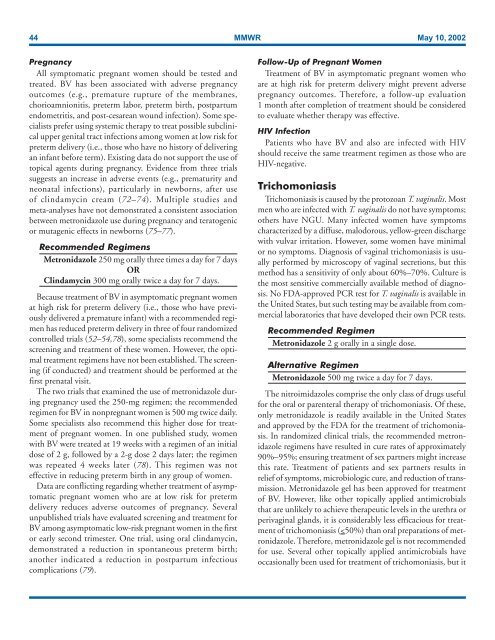Create successful ePaper yourself
Turn your PDF publications into a flip-book with our unique Google optimized e-Paper software.
44 MMWR May 10, 2002<br />
Pregnancy<br />
All symptomatic pregnant women should be tested and<br />
treated. BV has been associated with adverse pregnancy<br />
outcomes (e.g., premature rupture of the membranes,<br />
chorioamnionitis, preterm labor, preterm birth, postpartum<br />
endometritis, and post-cesarean wound infection). Some specialists<br />
prefer using systemic therapy to treat possible subclinical<br />
upper genital tract infections among women at low risk for<br />
preterm delivery (i.e., those who have no history of delivering<br />
an infant before term). Existing data do not support the use of<br />
topical agents during pregnancy. Evidence from three trials<br />
suggests an increase in adverse events (e.g., prematurity and<br />
neonatal infections), particularly in newborns, after use<br />
of clindamycin cream (72–74). Multiple studies and<br />
meta-analyses have not demonstrated a consistent association<br />
between metronidazole use during pregnancy and teratogenic<br />
or mutagenic effects in newborns (75–77).<br />
Recommended Regimens<br />
Metronidazole 250 mg orally three times a day for 7 days<br />
OR<br />
Clindamycin 300 mg orally twice a day for 7 days.<br />
Because treatment of BV in asymptomatic pregnant women<br />
at high risk for preterm delivery (i.e., those who have previously<br />
delivered a premature infant) with a recommended regimen<br />
has reduced preterm delivery in three of four randomized<br />
controlled trials (52–54,78), some specialists recommend the<br />
screening and treatment of these women. However, the optimal<br />
treatment regimens have not been established. The screening<br />
(if conducted) and treatment should be performed at the<br />
first prenatal visit.<br />
The two trials that examined the use of metronidazole during<br />
pregnancy used the 250-mg regimen; the recommended<br />
regimen for BV in nonpregnant women is 500 mg twice daily.<br />
Some specialists also recommend this higher dose for treatment<br />
of pregnant women. In one published study, women<br />
with BV were treated at 19 weeks with a regimen of an initial<br />
dose of 2 g, followed by a 2-g dose 2 days later; the regimen<br />
was repeated 4 weeks later (78). This regimen was not<br />
effective in reducing preterm birth in any group of women.<br />
Data are conflicting regarding whether treatment of asymptomatic<br />
pregnant women who are at low risk for preterm<br />
delivery reduces adverse outcomes of pregnancy. Several<br />
unpublished trials have evaluated screening and treatment for<br />
BV among asymptomatic low-risk pregnant women in the first<br />
or early second trimester. One trial, using oral clindamycin,<br />
demonstrated a reduction in spontaneous preterm birth;<br />
another indicated a reduction in postpartum infectious<br />
complications (79).<br />
Follow-Up of Pregnant Women<br />
Treatment of BV in asymptomatic pregnant women who<br />
are at high risk for preterm delivery might prevent adverse<br />
pregnancy outcomes. Therefore, a follow-up evaluation<br />
1 month after completion of treatment should be considered<br />
to evaluate whether therapy was effective.<br />
HIV Infection<br />
Patients who have BV and also are infected with HIV<br />
should receive the same treatment regimen as those who are<br />
HIV-negative.<br />
Trichomoniasis<br />
Trichomoniasis is caused by the protozoan T. vaginalis. Most<br />
men who are infected with T. vaginalis do not have symptoms;<br />
others have NGU. Many infected women have symptoms<br />
characterized by a diffuse, malodorous, yellow-green discharge<br />
with vulvar irritation. However, some women have minimal<br />
or no symptoms. Diagnosis of vaginal trichomoniasis is usually<br />
performed by microscopy of vaginal secretions, but this<br />
method has a sensitivity of o<strong>nl</strong>y about 60%–70%. Culture is<br />
the most sensitive commercially available method of diagnosis.<br />
No FDA-approved PCR test for T. vaginalis is available in<br />
the United States, but such testing may be available from commercial<br />
laboratories that have developed their own PCR tests.<br />
Recommended Regimen<br />
Metronidazole 2 g orally in a single dose.<br />
Alternative Regimen<br />
Metronidazole 500 mg twice a day for 7 days.<br />
The nitroimidazoles comprise the o<strong>nl</strong>y class of drugs useful<br />
for the oral or parenteral therapy of trichomoniasis. Of these,<br />
o<strong>nl</strong>y metronidazole is readily available in the United States<br />
and approved by the FDA for the treatment of trichomoniasis.<br />
In randomized clinical trials, the recommended metronidazole<br />
regimens have resulted in cure rates of approximately<br />
90%–95%; ensuring treatment of sex partners might increase<br />
this rate. Treatment of patients and sex partners results in<br />
relief of symptoms, microbiologic cure, and reduction of transmission.<br />
Metronidazole gel has been approved for treatment<br />
of BV. However, like other topically applied antimicrobials<br />
that are u<strong>nl</strong>ikely to achieve therapeutic levels in the urethra or<br />
perivaginal glands, it is considerably less efficacious for treatment<br />
of trichomoniasis (


